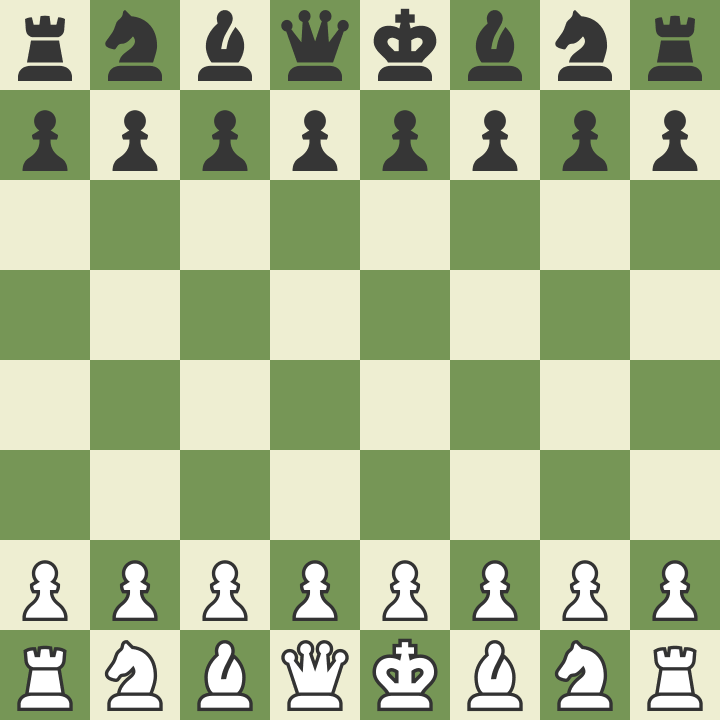
Chess is a game of strategy and intellect, and it begins with the simple yet crucial task of setting up the chess board. Whether you are new to the game or brushing up on your skills, this How-to-Guide, supplemented with a video tutorial, will ensure you set up your chess board correctly every time.
Chess Board Orientation and Basic Rules
What is the Correct Orientation of a Chess Board?
The correct orientation of the chessboard is essential. Begin by laying out the board with a light square in the bottom-right corner. The phrase “white on the right” often reminds this setup, ensuring that each side of the board is set up correctly.
Understanding Basic Chess Board Setup Rules
Setting up a chess board involves following some fundamental rules. Each player has 16 pieces: 8 pawns, 2 rooks, 2 knights, 2 bishops, a queen, and a king, all arranged in a specific order for fair play.
Setting Up Chess Pieces
- How to Place Each Chess Piece Correctly: Let’s start with the pawns. Place all eight pawns on the second row, clearing the pile of pieces and making room for the more crucial pieces.
- Setting Up Rooks: The Corner Towers: Your rooks, or “corner towers,” are placed in the board’s corners. This positioning symbolizes the rooks being like towers in a real castle.
- Knights Beside the Rooks: The Smelly Horses: Next, place your knights beside the rooks. A playful way to remember this is to imagine placing some “smelly horses” on the board, keeping them far from the king and queen.
- Bishops: Between Knights and Royalty: The bishops are set next to the knights. They stand between the knights and the royal couple (the king and queen), completing the second row of your army.
- Queen on Her Color: The queen goes on her own color. This means the white queen is placed on a light square and the black queen on a dark square. This rule is crucial for correct placement.
- King: Taking His Rightful Place: Finally, place your king on the last remaining square beside the queen. By now, there should be only one vacant square, making it clear where the king belongs.

Step-by-Step Chess Setup Guide
Let’s quickly summarize the steps:
- Lay out the board with a light square in the bottom-right corner.
- Place all pawns on the second row.
- Set the rooks in the corners.
- Position the knights next to the rooks.
- Place the bishops beside the knights.
- Put the queen on her color.
- Place the king on the last square.
- Remember, in chess, White moves first.
Chess Setup Video Tutorial: Visual Help
For a visual demonstration, refer to the accompanying Chess Setup Video Guide. This will help ensure you’ve set up your board correctly.

Tips for Beginners: Beginner Chess Board Setup Tips and Tricks
For beginners, the key is repetition. Practice setting up the board multiple times to memorize the placement of the pieces. Remembering fun cues, like “smelly horses” for knights or “queen on her color,” can also be helpful.
For beginners, chess can seem complex, but it’s a rewarding game that sharpens your mind and strategy skills. Here are essential tips and tricks to help you start your chess journey confidently.
- Understand the Value of Each Piece: In chess, different pieces have different values and abilities. Pawns are worth 1 point, knights and bishops 3, rooks 5, the queen 9, and the king has infinite value since losing it means losing the game. Understanding this helps you make better decisions about which pieces to sacrifice and which to protect.
- Control the Center of the Board: The center squares (d4, d5, e4, e5) are the most crucial areas of the board. Controlling these squares gives your pieces greater mobility and can restrict your opponent’s movements.
- Develop Your Pieces Early: Focus on developing your knights and bishops in the opening. Moving them towards the center allows them to control more of the board. Avoid moving the same piece multiple times in the opening, as this can waste valuable time.
- Don’t Rush to Move Your Queen: Moving the queen too early can expose her to attacks and limit her effectiveness. Develop your minor pieces (knights and bishops) before bringing out your queen.
- King Safety is Key: Always be mindful of your king’s safety. This often means castling early in the game, which tucks your king away safely and connects your rooks.
- Learn from Your Mistakes: After each game, review your moves and try to understand any mistakes you made. Learning from these will improve your play over time.
- Practice with Puzzles: Chess puzzles are an excellent way to improve your tactical skills. They help you recognize patterns and improve your problem-solving abilities.
- Play Regularly: Regular practice is the best way to improve. Try playing with slightly better opponents, as this challenges you to raise your game.
- Study Basic Endgames: Understanding simple endgames, such as king and pawn against king, can give you an edge in close matches.
- Enjoy the Game: Remember, chess is a game and is meant to be enjoyed. Don’t get discouraged by losses; every game, win or lose, is a learning opportunity.
By incorporating these tips into your chess practice, you’ll build a strong foundation in understanding the game. Chess is a continuous learning journey, and every game is a step forward in your development as a player. Happy playing!
Other Interesting Articles:
- Top 10 Tallest Walls in the World
- What Does TFW Mean on iPhone
- How to Pair Sony WF 1000XM4
- How To Fix “Nest Thermostat Not Charging or Low Battery” Issue
- How To Watch Court TV Channel on TV?
- Is Whoop 4.0 waterproof?
- How To Set Alarm on Apple Watch?
FAQ: Setting Up a Chess Board
What’s the difference between the king’s and queen’s starting positions?
The key difference lies in their placement relative to their color. The queen is always placed on a square of her own color (white queen on a white square and black queen on a black square). The king is placed on the remaining square next to the queen. This rule ensures that the queens always face each other at the start of the game.
Is there a specific side for white and black pieces on a chess board?
Yes, there is. The player with the white pieces always occupies the side of the board where the bottom-right square is light-colored. Correspondingly, the player with the black pieces takes the side where this square is dark. This setup is a universal standard in chess.
What are common mistakes to avoid when setting up a chess board?
Common mistakes include incorrectly orienting the board (the light square should be on the bottom-right corner), placing the king and queen on incorrect squares, and setting up the pawns on the wrong row. Double-checking the board orientation and the placement of the king and queen can help avoid these errors.
How do you set up a chess board for different chess variations?
For different chess variations like Chess960 (Fischer Random Chess), the setup of the back-row pieces (other than pawns) varies. Each piece, except pawns, has a specific starting position that can change game by game. However, pawns always occupy the second row. It’s important to understand the rules of each variation for correct setup.
Are there any tips for remembering how to set up a chess board correctly?
A few mnemonic tips can be helpful: remember “white on the right” to orient the board correctly, and “queen on her color” to place the queen correctly. Setting up the board multiple times and practicing will also help memorize the correct setup. Visual aids or diagrams can be useful references for beginners.
Our Conclusion
Setting up a chess board correctly is the first step in the fascinating world of chess. With this guide and video, you are equipped to start your journey. Remember, “white on the right,” and have fun setting the stage for a game that sharpens your mind and entertains. Welcome to the world of chess!





Leave a Reply